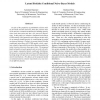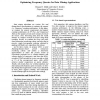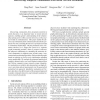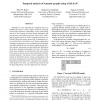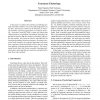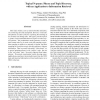ICDM
2007
IEEE
14 years 5 months ago
2007
IEEE
Consensus clustering and semi-supervised clustering are important extensions of the standard clustering paradigm. Consensus clustering (also known as aggregation of clustering) ca...
ICDM
2007
IEEE
14 years 5 months ago
2007
IEEE
Complex networks have been used successfully in scientific disciplines ranging from sociology to microbiology to describe systems of interacting units. Until recently, studies of...
ICDM
2007
IEEE
14 years 5 months ago
2007
IEEE
It is crucial to segment customers intelligently in order to offer more targeted and personalized products and services. Traditionally, customer segmentation is achieved using sta...
ICDM
2007
IEEE
14 years 5 months ago
2007
IEEE
In spite of the popularity of probabilistic mixture models for latent structure discovery from data, mixture models do not have a natural mechanism for handling sparsity, where ea...
ICDM
2007
IEEE
14 years 5 months ago
2007
IEEE
Data mining algorithms use various Trie and bitmap-based representations to optimize the support (i.e., frequency) counting performance. In this paper, we compare the memory requi...
ICDM
2007
IEEE
14 years 5 months ago
2007
IEEE
Discovering communities from documents involved in social discourse is an important topic in social network analysis, enabling greater understanding of the relationships among act...
ICDM
2007
IEEE
14 years 5 months ago
2007
IEEE
ASALSAN is a new algorithm for computing three-way DEDICOM, which is a linear algebra model for analyzing intrinsically asymmetric relationships, such as trade among nations or th...
ICDM
2007
IEEE
14 years 5 months ago
2007
IEEE
In this paper we address the problem of combining multiple clusterings without access to the underlying features of the data. This process is known in the literature as clustering...
ICDM
2007
IEEE
14 years 5 months ago
2007
IEEE
Most topic models, such as latent Dirichlet allocation, rely on the bag-of-words assumption. However, word order and phrases are often critical to capturing the meaning of text in...
ICDM
2007
IEEE
14 years 5 months ago
2007
IEEE

